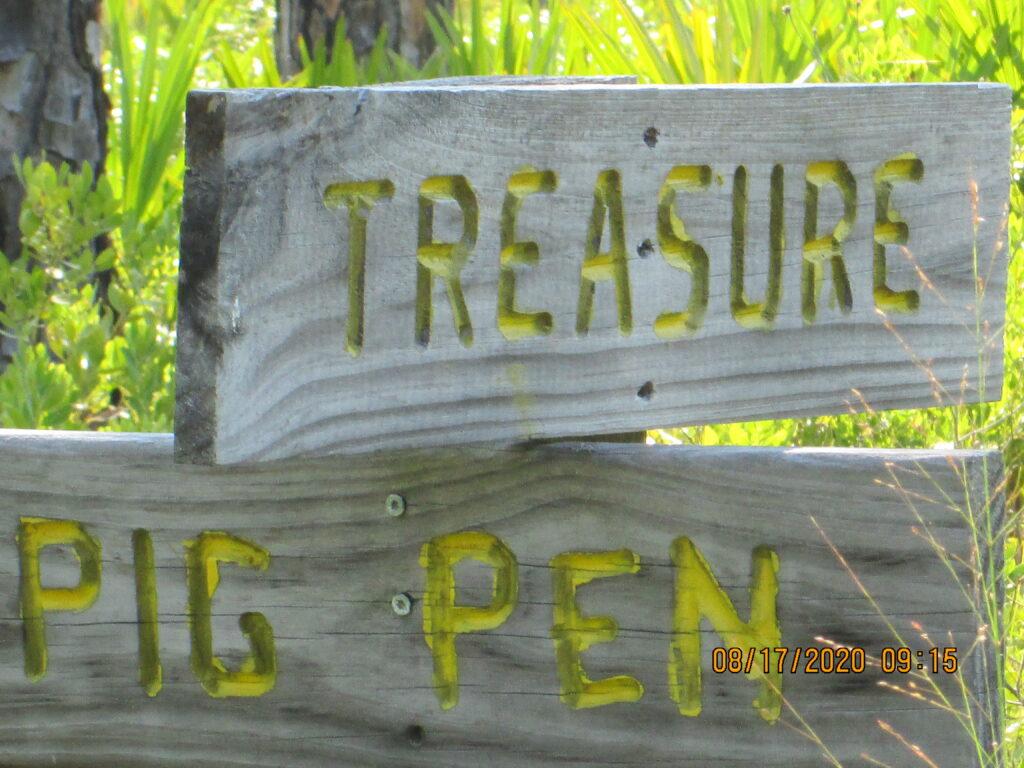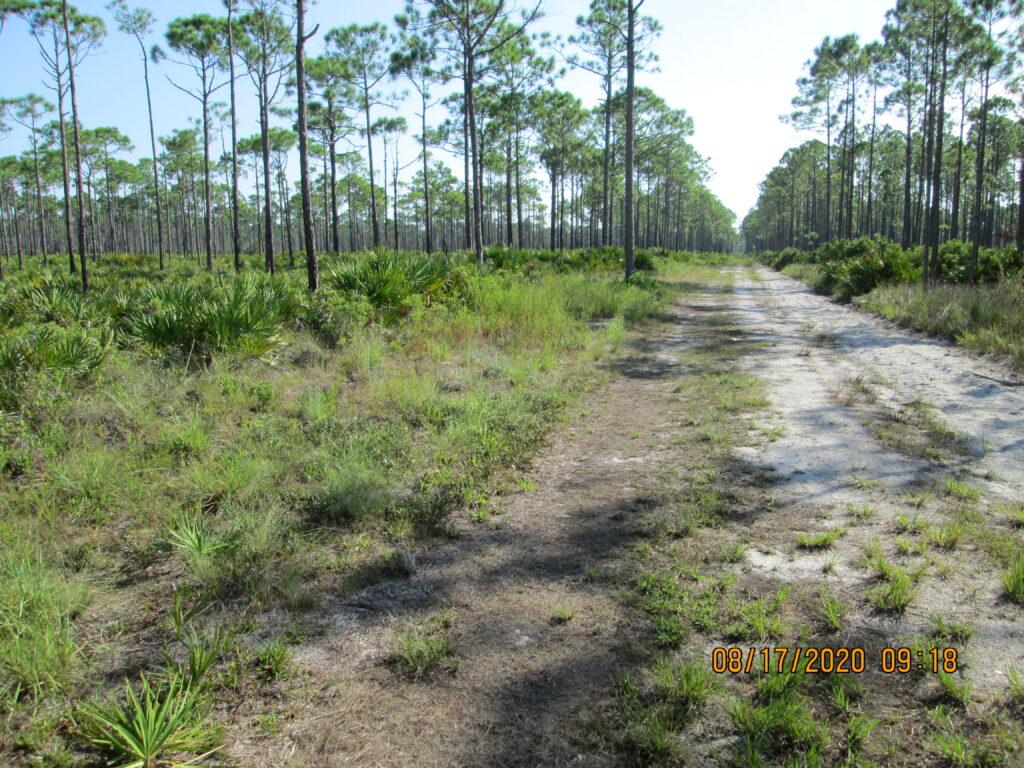Explore Pig Pen Road for a glimpse at some of the state’s most prolific wildlife
If we walk all the trails, roads, and paths at the St. Joseph Bay State Buffer Preserve we will have covered 5, 027 acres. Wow! What an adventure on the road to getting heathy!
This fall will be an even better time to walk the trails as it will be a little cooler (we hope). A former neighbor reported that he had walked every road, trail, path many times — and saved himself heart surgery in the process.
The next road on our trail map is Pig Pen Road.
The name of this road is of obvious origins and was named while the property belonged to a private individual. The pig pens that dotted the area have since been removed by site volunteers, alternative spring breakers, and Buffer staff.
Pig Pen is 0.79 miles from Treasure Road to Grassy Road. On the map you see a 0.2 loop which dead ends and you must go back the way you came. If it has not been cut recently you might just want to put it on a list for another time.
At the beginning of restoration efforts deer stands, along with the pig pens, near Pig Pen Road were removed by staff and volunteers. They have been disposed of as there is no hunting allowed now on Buffer Preserve property.
Pig Pen Road overlooks a wetlands area of the Preserve. It has undergone prescribed burning twice in the last few years.
“This zone is one that had no history of being burned. In order to reduce the fuel load, it was deemed necessary and important to burn the area,” said Dylan Shoemaker, preserve manager. “If a wildfire should result from a lightning strike it will be much easier to maintain. It’s in everyone’s best interest to keep the burns current and in proper rotation to reduce chances of wildfire for the Buffer Preserve and our neighbors.”
Let’s think about the pigs on Pig Pen Road and in the Uplands. One question to consider — how did they get to our area? Hernando DeSoto brought them to the New World in 1539. It’s their descendants, nearly 500 years later, who number in the millions. Now that number is closer to three million and growing.
It’s a fact: all 67 counties in the state have feral hogs, and they are in at least 35 states, reports from the University of Florida research publication tell us.
A wild hog (Sus scrofa) by any other name might be feral hog, feral swine, feral pig, wild boar, wild pig or piney woods rooter. While they are not native to Florida, they have been here for hundreds of years.
They are prolific reproducers. When a group actively hunting them tries to locate them to eradicate them, they are not to be found. Even with traps they are hard to capture.
While these wild hogs usually weigh from 100 to 200 pounds, and they might measure 5 to 6 ft long, their favorite food is acorns, however, they will eat almost anything. Researchers Bill Giuliano and George Tanner of the University of Florida determined this from their research.

Why are they a nuisance? They root the ground, disturb rare plants, disturb soil and ground cover, vegetation and leave the area looking like it’s been plowed.
They feed by rooting with their broad snouts. While their favorite food is acorns, they will eat anything. In our area they eat a wide variety of plants and animals but prefer oak-cabbage, palm hammocks, freshwater marshes and sloughs in pine flatwoods or agriculture areas.
They travel in small groups or alone and have been seen occasionally crossing the roads. Sometimes employees can hear them in the uplands and still not see them. According to an accomplished hunter, the male boar will be the lone hog or single track, as females travel in packs.
The problem with the pigs is their rooting (the effects of consuming, knocking down and trampling large amounts of native vegetation and crops) in the Buffer Preserve, where they don’t distinguish the non-important plants/roots from the rare and very protected ones. They leave evidence when they have been rooting though – you can’t miss it. It can look like a large piece of heavy equipment has been used.
George Tanner, from the University of Florida reports in his research, “Wild hogs compete for food with other game animals such as deer, turkeys and squirrels, and they may consume the nests and young of their fine sense of smell, wild hogs can find and consume young domestic livestock, including poultry, lambs and goats. Millions of dollars are spent each year to prevent damage from hogs.”
Are you likely to see wild pigs on your walks in the Buffer Preserve? It’s not likely at all. Only occasionally is one spotted in the distance, maybe crossing the road. There have not been any scares or encounters with these pigs in the Preserve.
If you have any questions, we will find the answer. You can call 850-229-1787. Things you might want to bring are sunscreen, water, phone, sturdy shoes or boots. Everything is dry right now however, at times there is areas with standing water. Get out in the sunshine, enjoy nature, find something interesting then google it when you return home. You are never too old to learn (or relearn) about nature!
As stated, in previous articles, our volunteers are our greatest resource. Some come from near or far and stay on site to help us. Some are locals who live here, shop here, belong here, and support our efforts and goals. These local volunteers make up the Board of the Friends of the St. Joseph Bay Preserves.
Stop in the Visitors Center for an application or check out the Friends’ website at stjosephbaypreserve.org for an application.

This story is part of a series exploring the many trails at the St. Joseph Bay State Buffer Preserve.


Meet the Editor
David Adlerstein, The Apalachicola Times’ digital editor, started with the news outlet in January 2002 as a reporter.
Prior to then, David Adlerstein began as a newspaperman with a small Boston weekly, after graduating magna cum laude from Brandeis University in Waltham, Massachusetts. He later edited the weekly Bellville Times, and as business reporter for the daily Marion Star, both not far from his hometown of Columbus, Ohio.
In 1995, he moved to South Florida, and worked as a business reporter and editor of Medical Business newspaper. In Jan. 2002, he began with the Apalachicola Times, first as reporter and later as editor, and in Oct. 2020, also began editing the Port St. Joe Star.